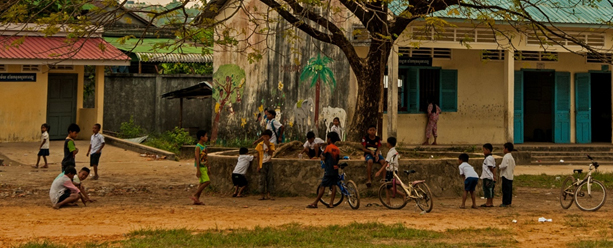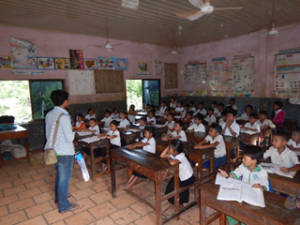The integrated vector control in schools can mitigate the epidemic peaks and thus help reduce overcrowding in hospitals during the epidemic season of dengue.
Public health concern
The country’s economic development leads to a frantic development of peri-urban areas around Phnom Penh but in the provinces as well, particularly in cities that are at important road junctions. These transition zones where urban density is juxtaposed with rural activities are subject to rapid changes in ecosystems caused by human activity. It has already been demonstrated in other countries of the region that:
- the expansion of suburban areas, lack of sewage system and land degradation are causes of proliferation of Aedes aegypti and Aedes albopictus, mosquito vectors of Dengue virus, Chikungunya and Zika and
- a combined high density of human hosts increases the risk of dengue transmission
Annual dengue epidemic peaks cause serious health problems in the population and mainly in children and represent a social and economic burden on the most vulnerable communities. These outbreaks also disrupt the operation of the pediatric units in hospitals; the work overload can impair the quality of care and cause shortages of drugs and other consumables. However, the quality of care for hospitalized children is closely correlated with mortality (WHO).
Relevance of the project

It has been shown that the risk of dengue infection is explained only in 60% of cases by the fact of living under the same roof as a dengue case. The children, who account for most dengue cases are on average infected twice before the age of 10 years. These children spend most of their day at school and the school yard is used as a playground for children outside school time. Actually the vector, Aedes aegypti, which can live in all types of premises and their immediate environment, bites during the day time so during school hours, recreation and leisure schools, especially those in peri-urban areas

are certainly hot spots for transmission of dengue among children, knowing that these children contaminated at school will be a source of horizontal transmission of the virus at home and for the neighborhood. Targeting preferential areas for transmission, to organize an integrated vector control during the dengue season should be more cost effective in comparison of dispersal interventions in area after confirmation of dengue cases.
On the other hand, it has been demonstrated (IPC / CNRS-2015) that people infected with dengue virus but remaining asymptomatic can infect mosquitoes that bite them. These cases with those mildly symptomatic or people in incubation, yet account for three quarters of dengue infections; they are therefore fully involved in the chain of transmission. This explains why children infected with dengue virus remain sources of transmission of the disease to school.
Objective:
The proposed study aims to measure whether the implementation of an integrated vector control strategy focusing schools, combined with an educational program can:

– mitigate peak of dengue and dengue-like syndromes (leptospirosis, chikungunya, zika)
– have a positive impact on the activities of health centers which are generally overcrowded during these transmission peaks.
Specific objectives:
- To set up an integrated vector control strategy in schools and assess its impact on dengue transmission
- To strengthen passive surveillance of dengue-like syndromes that occurred in health centers, district hospitals and the provincial hospital in the study area
- To improve differential diagnosis with leptospirosis by adapted laboratory testing
- To establish a serological monitoring by saliva test to assess dengue transmission in the population of school children in the study areas
- To evaluate and compare the virological characteristics of dengue virus circulating in the population in the areas of study.
